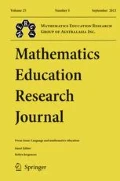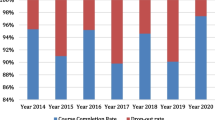Abstract
This study provides an overview of the support provided for academic numeracy for first-year students across six Australian regional universities. Survey analysis of university academics provided an overview of the approaches used in academic numeracy in diverse cohorts. Further investigations via semi-structured interviews and secondary data were performed, providing details of the level of academic numeracy required in the subjects offered, identification of at-risk students and strategies for student support, and student responses to service provision. A case study at one university provided a more detailed view of the factors influencing attrition in first-year academic numeracy subjects. This case study highlighted issues related to a one-size-fits-all approach and findings argue for a more nuanced cohort-based approach that combines conventional statistical analysis with analysis that provides a more detailed view of complex scenarios. The study suggests that while support services are not responding well to the issue of attrition, better targeting individual student support may lead to improvements.
Similar content being viewed by others
References
Australian Academy of Science. (2015). The importance of advanced physical and mathematical sciences to the Australian economy. Canberra: Australian Academy of Science.
Australian Academy of Science. (2016). The mathematical sciences in Australia: a vision for 2025. Canberra: Australian Academy of Science.
Barrington, F., & Evans, M. (2016). Year 12 mathematics participation in Australia – the last ten years. Melbourne: Australian Mathematical Sciences Institute.
Boyd, W., Foster, A., Smith, J., & Boyd, W. E. (2014). Feeling good about teaching mathematics: addressing anxiety amongst pre-service teachers. Creative Education, 5, 207–217.
Bressoud, D.M. (2014). Attracting and retaining students to complete two-and four-year undergraduate degrees in STEM: the role of undergraduate mathematics education. Commissioned paper prepared for the committee on barriers and opportunities in completing 2-year and 4-year STEM degrees. Washington, DC: National Academy of Sciences.
Burnheim, C., & Harvey, A. (2016). Far from the studying crowd? Regional and remote students in higher education. In A. Harvey, C. Burnheim, & M. Brett (Eds.), Student equity in Australian higher education (pp. 143–162). Singapore: Springer.
Clarke, J., Nelson, K., & Stoodley, I. (2011). Capability maturity models: a discussion paper and a work in progress. SESR-MM Report 001 prepared for the ALTC Project: Establishing a framework for transforming student engagement, success and retention in higher education institutions. Brisbane: Queensland University of Technology.
Coates, H. (2014). Students' early departure intentions and the mitigating role of support. Australian Universities' Review, 56, 20–29.
Cohen, L., Manion, L., & Morrison, K. (2013). Research methods in education. New York: Routledge.
Cooke, A., Cavanagh, R., Hurst, C., & Sparrow, L. (2011). Situational effects of mathematics anxiety in pre-service teacher education. Paper presented at the AARE Conference, Hobart, Tasmania.
Crocker, R., Kahla, M., & Allen, C. (2014). Fixing advising: a model for faculty advising. Research in Higher Education, 26, 1–9.
Croft, A., Harrison, M., & Robinson, C. (2009). Recruitment and retention of students–an integrated and holistic vision of mathematics support. International Journal of Mathematical Education in Science and Technology, 40, 109–125.
Department of Education and Training. (2017). Improving retention, completion and success in higher education (Higher Education Standards Discussion Paper, June 2017). Canberra: Australian Government.
Farr-Wharton, B., Charles, M., Keast, R., Woolcott, G., & Chamberlain, D. (2018). Why lecturers still matter: the impact of lecturer-student exchange on student engagement and intention to leave university prematurely. Higher Education, 75, 167–185.
Finkel, A. (2018). Winning the game of Faculty. Universities Australia Higher Education Conference Dinner Address, Parliament House, Canberra, Wednesday 28th February 2018. Retrieved from www.chiefscientist.gov.au/wp-content/uploads/Universities-Australia-dinner-address.pdf.
Gale, T., & Parker, S. (2013). Widening participation in Australian higher education. Report to the Higher Education Funding Council for England (HEFCE) and the Office of Fair Access (OFFA), England. Lancashire, UK: CFE (Research and Consulting) Ltd, Leicester, UK and Edge Hill University.
Galligan, L. (2013). A systematic approach to embedding academic numeracy at university. Higher Education Research and Development, 32, 734–747.
Galligan, L., & Hobohm, C. (2015). Investigating students’ academic numeracy in 1st level university programs. Mathematics Education Research Journal, 27, 129–145.
Geiger, V., Goos, M., & Forgasz, H. (2015). A rich interpretation of numeracy for the 21st century: a survey of the state of the field. ZDM, 47, 531–548.
Grebennikov, L., & Shah, M. (2012). Investigating attrition trends in order to improve student retention. Quality Assurance in Education, 20, 223–236.
Groen, L., Coupland, M., Langtry, T., Memar, J., Moore, B., & Stanley, J. (2015). The mathematics problem and mastery learning for first-year, undergraduate STEM students. International Journal of Learning, Teaching and Educational Research, 11, 141–160.
Hayden, M. (2010). Student attrition from higher education institutions. In P. L. Peterson, E. L. Baker, & B. McGaw (Eds.), The International Encyclopedia of Education, Vol. 4 (3rd ed., pp. 467–472). Oxford: Elsevier.
Holdren, J., & Lander, E. (2012). Report to the president – engage to excel: producing one million additional college graduates with degrees in Science, Technology, Engineering, and Mathematics. Retrieved from Washington, DC: President’s Council of Advisors on Science and Technology.
Hurst, C., & Cooke, A. (2014). Seeking a balance: helping pre-service teachers develop positive attitudes towards mathematics as they develop competency. Open Journal of Social Sciences, 2, 210–216.
Kim, C., & Keller, J. (2010). Motivation, volition and belief change strategies to improve mathematics learning. Journal of Computer Assisted Learning, 26, 407–420.
King, D., & Cattlin, J. (2015). The impact of assumed knowledge entry standards on undergraduate mathematics teaching in Australia. International Journal of Mathematical Education in Science and Technology, 46, 1032–1045.
Lake, W. W., & Boyd, W. E. (2015). Is the university system in Australia producing deep thinkers? The Australian Universities' Review, 57, 54–59.
Lake, W., Boyd, W., & Boyd, W. (2015). The propensity of a science-based discipline towards surface learning compared to the arts—a fresh look at two cultures. Creative Education, 6, 1733–1741.
Lake, W., Boyd, W., Boyd, W., & Hellmundt, S. (2017a). Just another student survey? Point of contact survey feedback enhances the student experience and lets researchers gather data. Australian Journal of Adult Learning, 57, 82–104.
Lake, W., Wallin, M., Woolcott, G., Boyd, W. E., Foster, A., Markopoulos, C., & Boyd, W. (2017b). Applying an alternative mathematics pedagogy for students with weak mathematics: meta-analysis of alternative pedagogies. International Journal of Mathematical Education in Science and Technology, 48, 215–228.
Lawrence, J. (2013). Designing and evaluating an empowering online pedagogy for commencing students: a case study. International Journal of the First Year in Higher Education, 4, 49–61.
Lyons, T., Cooksey, R., Panizzon, D., Parnell, A., & Pegg, J. (2006). Science, ICT and mathematics education in rural and regional Australia: The SiMERR national survey. A research report prepared for the Department of Education, Science and Training. Armidale, Australia: National Centre of Science, ICT and Mathematics Education for Rural and Regional Australia, and the University of New England.
Macbean, J. (2004). Students’ conceptions of, and approaches to, studying mathematics as a service subject at undergraduate level. International Journal of Mathematical Education in Science and Technology, 35, 553–564.
MacGillivray, H., & Wilson, T. (2008). Quantitative diversity: disciplinary and cross-disciplinary mathematics and statistics support in Australian universities. Canberra: Australian Learning and Teaching Council.
Mack, J., & Walsh, B. (2013). Mathematics and science combinations NSW HSC 2001–2011 by gender. Retrieved from http://www.maths.usyd.edu.au/u/SMS/MWW2013.pdf.
Maltas, D., & Prescott, A. (2014). Calculus-based mathematics: an Australian endangered species? Australian Senior Mathematics Journal, 28, 39–49.
Nelson, K., Clarke, J., Kift, S., & Creagh, T. (2011). Trends in policies, programs and practices in the Australasian first year experience literature 2000–2010. Brisbane: Queensland University of Technology.
Nelson, K., Picton, C., McMillan, J., Edwards, D., Devlin, M., & Martin, K. (2017). Understanding the completion patterns of equity students in regional universities. Perth: National Centre for Student Equity in Higher Education (NCSEHE), Curtin University.
Office of the Chief Scientist. (2014). Science, technology, engineering and mathematics: Australia’s future. Canberra: Australian Government.
Quinn, F., & Lyons, T. (2016). Rural first year university science students: as engaged, aspirational and motivated as anyone but different science ‘choices’ in year 12 and university. Australian and International Journal of Rural Education, 26, 42–53.
Rylands, L. J., & Coady, C. (2009). Performance of students with weak mathematics in first-year mathematics and science. International Journal of Mathematical Education in Science and Technology, 40, 741–753.
Sharma, H., & Nasa, G. (2014). Academic self-efficacy: a reliable predictor of educational performances. British Journal of Education, 2, 57–64.
Smith, P., Ladewig, M., & Prinsley, R. (2018). Improving the mathematics performance of Australia’s students. Office of the Chief Scientist—Occasional Paper, July 2018. Canberra: Australian Government.
Stone, M., Walton, T., Clark, C., & Ligertwood, L. (2016). The influence of support and development programs and services on the success of university students from low socioeconomic status backgrounds. JANZSSA-Journal of the Australian and New Zealand Student Services Association, 24, 25–38.
van der Meer, J., Scott, S., & Pratt, K. (2018). First semester academic performance: the importance of early indicators of non-engagement. Student Success, 9, 1–12.
Walton, T. (2016). Using a mixed methods approach to investigate university student success after support service interaction: a case study and analysis. JANZSSA-Journal of the Australian and New Zealand Student Services Association, 24, 38–49.
Wandel, A. P., Robinson, C., Abdulla, S., Dalby, T., Frederiks, A., & Galligan, L. (2015). Students’ mathematical preparation: differences in staff and student perceptions. International Journal of Innovation in Science and Mathematics Education, 23, 82–93.
Whannell, R., & Allen, B. (2012). First year mathematics at a regional university: does it cater to student diversity? The International Journal of the First Year in Higher Education, 3, 45–58.
Wienk, M. (2016). Discipline profile of the mathematical sciences. Melbourne: University of Melbourne of behalf of the Australian Mathematical Sciences Institute.
Woolcott, G., Chamberlain, D., Keast, R., & Farr-Wharton, B. (2017a). Modelling success networks to improve the quality of undergraduate education. Quality in Higher Education, 23, 120–137.
Woolcott, G., Pfeiffer, L., Yeigh, T., Donnelly, J., Whannell, R., & Scott, A. (2017b). Enhancing science and mathematics teacher education: evaluating an enhancement module for science pre-service teachers. International Journal of Learning and Change, 9, 131–144.
Woolcott, G., Chamberlain, D., Whannell, R., & Galligan, L. (2018). Examining undergraduate student retention in mathematics using network analysis and relative risk. International Journal of Mathematical Education in Science and Technology, 50, 447–463.
Woolcott, G., Seton, C., Mason, R., Chen, O., Lake, W., Markopoulos, C., & Boyd, W. (2019). Developing a new generation MOOC (ngMOOC): a design-based implementation research project with cognitive architecture and student feedback in mind. European Journal of Open, Distance and E-learning, 22, 14–35.
Yin, R. K. (2013). Case study research: Design and methods (5th ed.). Beverley Hills: Sage publications.
Funding
Research for this article was funded by the Australian Government through the Higher Education Participation and Partnerships Program, National Priorities Pool–2015 as part of the project Bite size maths: Building mathematics capability of low SES students in regional/remote Australia.
Author information
Authors and Affiliations
Corresponding author
Additional information
Publisher’s note
Springer Nature remains neutral with regard to jurisdictional claims in published maps and institutional affiliations.
Appendix
Appendix
Rights and permissions
About this article
Cite this article
Woolcott, G., Galligan, L., Whannell, R. et al. How are we progressing with academic numeracy at regional universities? Perspectives from first-year undergraduate studies. Math Ed Res J 33, 451–468 (2021). https://doi.org/10.1007/s13394-020-00312-3
Received:
Revised:
Accepted:
Published:
Issue Date:
DOI: https://doi.org/10.1007/s13394-020-00312-3



